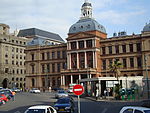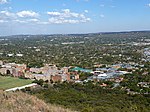Palace of Justice, Pretoria
Buildings and structures in PretoriaGauteng geography stubsPretoriaTourist attractions in Pretoria

The Palace of Justice forms part of the northern façade of Church Square in Pretoria. The building dates to the nineteenth century and was designed by the Dutch architect Sytze Wierda. It is currently the headquarters of the Gauteng Division of the High Court of South Africa. The foundation stone was laid on June 8, 1897 by South African Republic (ZAR) President Paul Kruger.The most famous political trial in South Africa's history, the Rivonia Trial, took place here. During the trial, Nelson Mandela and a number of other prominent African National Congress (ANC) members were charged with treason and subsequently jailed.
Excerpt from the Wikipedia article Palace of Justice, Pretoria (License: CC BY-SA 3.0, Authors, Images).Palace of Justice, Pretoria
Paul Kruger Street, Pretoria Tshwane Ward 60
Geographical coordinates (GPS) Address Nearby Places Show on map
Geographical coordinates (GPS)
| Latitude | Longitude |
|---|---|
| N -25.7475 ° | E 28.1878 ° |
Address
Ou Raadsaal
Paul Kruger Street
0126 Pretoria, Tshwane Ward 60
Gauteng, South Africa
Open on Google Maps









